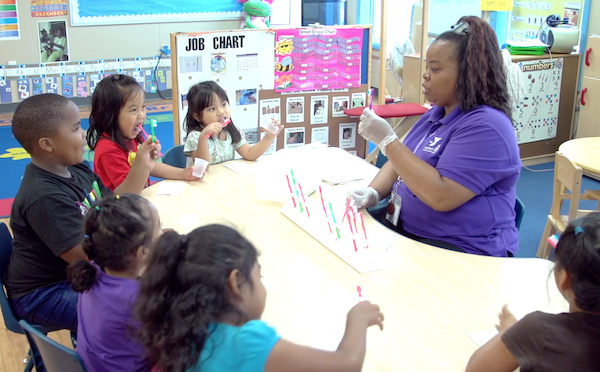
This Brush Up on Oral Health tip sheet is all about toothbrushing in a Head Start classroom. Head Start staff can help children brush and develop positive oral health habits that will last a lifetime. Scheduling time for children to brush their teeth with fluoride toothpaste during the program day ensures that children brush at least once a day.
This tip sheet answers questions about the amount of fluoride toothpaste to use, the benefits of brushing at the classroom table as a group, and how to clean and store toothbrushes.
Brushing with Fluoride Toothpaste
Daily brushing with fluoride toothpaste is very effective at preventing tooth decay. The American Academy of Pediatric Dentistry and other professional associations recommend that children begin using fluoride toothpaste as soon as the first tooth comes into the mouth. The amount of toothpaste to use is based on the child's age. For children younger than age 3, a grain of rice-sized amount is recommended. For children ages 3 to 6, a pea-sized amount is recommended.
Brushing at the Classroom Table
 A quick and structured approach to daily brushing in the classroom is to have children brush at the table as a group. The video, Steps for Toothbrushing at the Table: Growing Healthy Smiles in Early Care and Education Programs, and the Indian Health Service's Classroom Circle Brushing: Quick Reference Guide offer simple step-by-step approaches to brushing at the classroom table.
A quick and structured approach to daily brushing in the classroom is to have children brush at the table as a group. The video, Steps for Toothbrushing at the Table: Growing Healthy Smiles in Early Care and Education Programs, and the Indian Health Service's Classroom Circle Brushing: Quick Reference Guide offer simple step-by-step approaches to brushing at the classroom table.
There are many benefits of brushing at the table as a group:
- It provides a calm, orderly way to teach children how to brush.
- It takes less time when all children brush together and is less messy than brushing at the sink.
- It allows teachers to serve as role models by brushing their own teeth with children.
- It allows teachers sitting at the table with children to observe and encourage each child or make changes to their brushing method.
- It is less likely that children will pass bacteria (germs) from one toothbrush to another. Bacteria can easily spread when children rinse their toothbrushes under the same stream of water or if they play with their toothbrushes and the bristles touch each other.
- It provides an opportunity to include math and science concepts.
Cleaning and Storing Toothbrushes
Toothbrushes should be handled carefully to avoid spreading bacteria. Each child should have his or her own toothbrush. Remember to label each toothbrush with the child's name.
After brushing, toothbrushes should be rinsed with water to clean anything left on the bristles. Then, the toothbrushes should be stored in an upright position to air dry. Wet toothbrush bristles should not be covered because bacteria can grow on the bristles if they are kept in closed, dark spaces. If several toothbrushes are stored in the same holder, make sure there is enough space between toothbrushes so that they do not touch each other.
Toothbrushes should not be soaked in bleach water or other disinfecting solutions. Do not try to disinfect toothbrushes in dishwashers or microwaves, or by using ultraviolet devices, as doing so may damage the toothbrushes.
Download a PDF version to print and share.
Read more:
Resource Type: Article
National Centers: Health, Behavioral Health, and Safety
Audience: Teachers and Caregivers
Series: Brush Up on Oral Health (BUOH)
Last Updated: November 9, 2022
